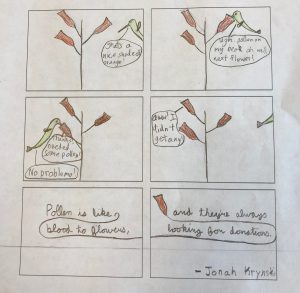Written by Giselle Serafin
Spring 2018
Middle school is an interesting age, where students are discovering themselves and their love of food systems. Although they may not express that love directly, having a Garden and Nutrition Program to give access to essential information at such a formative age is necessary and important. Working at Longfellow Middle School was an amazing experience. This unique internship stems from a partnership between the Berkeley Food Institute and the Berkeley Unified School District to connect UC Berkeley students to intern for either garden based learning, nutrition instruction, or both, as was my case in elementary and middle schools. The teacher that I worked with, Ellen McClure, was in charge of both the school’s gardens and teaching the nutrition classes, which gave our program a nice balance to bring in some of the fruits, vegetables, and herbs that we grew into the classroom to incorporate into our recipes.
From the first day, I realized how important this program is as an exposure to food production and the students relationship with food. The curriculum is incorporated into the students’ science class, where they rotate to take this course with Ellen every month. The students work in the garden a few days out of the week. This means they plant new seeds, weed and upkeep the garden, turn compost and water the plants. Although we are outside for a majority of the period, we also start every class with a lesson. This semester we focused on building observational scientific skills, such as nature drawing, for the first unit and pollination during the second unit. The header image is from one of the activities, where the students made pollinator comic strips that illustrate the pollination concepts they learned, and really shows how intelligent, clever, and passionate the students are. When the students aren’t in the garden, they are in the kitchen for the nutrition aspect of our program. They are separated into small of eight students and are expected to rely teamwork and collaboration to complete the recipe on their own, where my role is to answer any questions and make sure they are working safely and efficiently. There are four instructors in the nutrition class including myself, which means each one of us gets to take a group of students for concentrated attention.
I noticed that a lot of the vegetables that we grow are not the usual vegetables that the students eat at home because they had a lot of questions stemming both from curiosity and hesitance, they are middle schoolers of course. For example, we were working with dino kale and celeriac, and the students were really opposed to eating them because of the unfamiliarity. They are generally really good at following the directions and finishing a recipe, but when the food is ready at the end, they are shy about tasting something new especially in front of their friends. They don’t want to show their achilles heel in food knowledge. If I was a student at their age, I probably would feel the same. Food is such an intimate and culture driven activity that is shared with family and friends. In a way, trying new things can feel like a rejection or replacement of what they know and are used to. Especially in a nutrition class, where we learn how some options are healthier than others, it is not easy changing or modifying comfort or traditions.
However, when they do try the foods, almost always they are pleasantly surprised. They finish all of their plates and even ask for more. It is always difficult to break that first barrier of trying the food, which I’ve noticed happens at every cooking class. However, there are sometimes one or two students who refuse to try the food altogether, which is just part of middle school; they have a certain reputation to protect. No matter what we do, that barrier is still set up at the beginning of every class period, yet there is still room for growth. The students definitely feed off of each other’s energy, and it is interesting how reactions to the foods we make change from table to table. If one student with a lot of social power says they don’t want to try the food, it changes the whole tone of the table. While on the other side of the room, they all could be so positive and engaged.
Although the classes always end with positive results, I wonder if there is something more that we can do at the beginning of the class that would make the students more excited to try the new food. We need to make the food more familiar, so the students will not be so opposed to trying the new foods. This can stem from cooking the students family recipes, or bringing in family members to make certain dishes and share knowledge. Furthermore, it might be interesting to take pictures of the students enjoying the food and cooking with it, so that for the next year, it would not be as foreign. The students would then see students from similar backgrounds eating the foods and make the activity more familiar. Overall, the small pushback is normal, and food is definitely the way to a middle schooler’s heart. Working with the students in the garden, seeing them name their plants, cooking a meal together, and eating at the end of the day is a beautiful way to inspire the new generation of gardeners, nutritionists, and activists.

